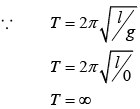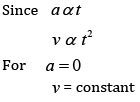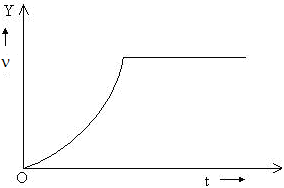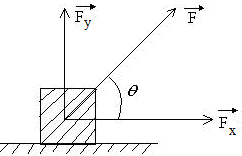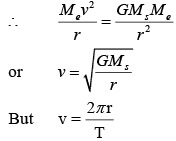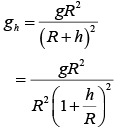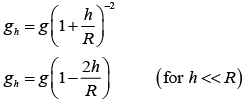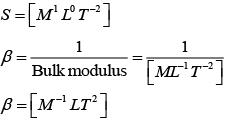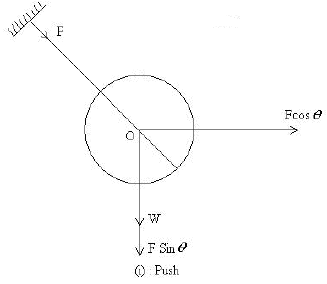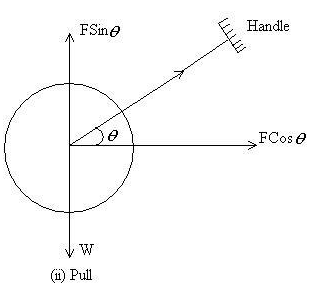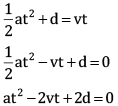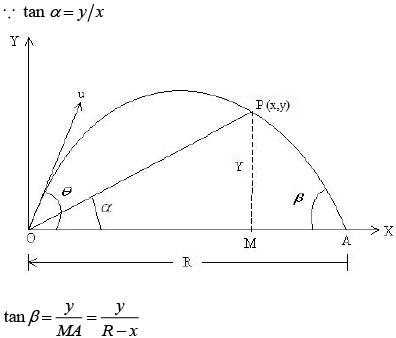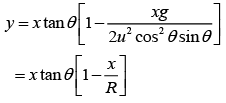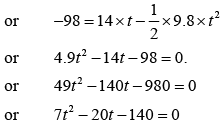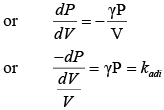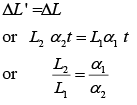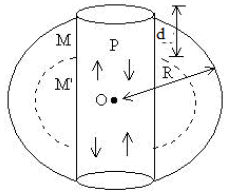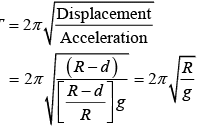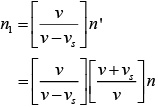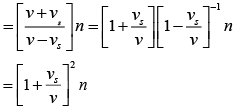Sample Paper 1 with Solution: Physics, Class 11 | Physics for Grade 11 PDF Download
Q.1: Will the momentum remain constant if some external force acts on the system? (1)
Ans:
No. it is true only for an isolated system.
if
Q.2: The Earth moving round the Sun in a circular orbit is acted upon by a force, and hence work must be done on the Earth by this force. Do you agree with this statement? (1)
Ans:
The statement is wrong. Work done is zero because the centripetal force cannot do any work on the earth.
Q.3: Suppose a cyclist is negotiating a curve of radius r with speed v . Write the conditions under which skidding will occur. (1)
Ans:
Skidding will occur in the event of:
(a) v (the speed of the cyclist) being large.
(b) r being small
(c) The road surface being slippery.
Q.4: Why does a cricket player lower his hands while catching a ball? (1)
Ans:
By lowering his hands, the cricket player increases the interval in which the catch is taken. This increase in time interval results in the less rate of change of momentum. Therefore, in accordance with Newton’s second law of motion, less force acts on his hands and the player saves himself from being hurt.
Q.5: Why do small bubbles have excess of pressure? (1)
Ans:
Excess pressure in a bubble
Lesser the value of radius of bubble ( r ), greater is the excess pressure.
Q.6: Which of the following processes shown here is reversible? Name the other process. (1)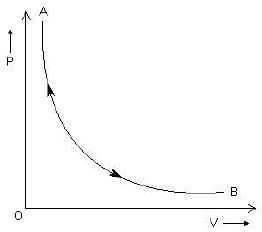
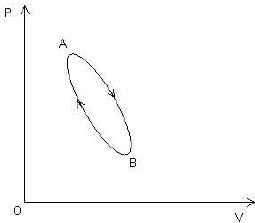
Ans:
(a) Reversible process
(b) Cyclic process
Q.7: Can a simple pendulum experiment be conducted inside a satellite? (1)
Ans:
Inside a satellite, the body is in a state of weightlessness So that the effective value of g is zero.
Thus, the pendulum will not oscillate at all, and therefore the experiment cannot be performed.
Q.8: Water in a closed tube is heated with one arm vertically placed above an arc lamp. The water will begin to circulate along the tube in the counter – clockwise direction. Is it true or false? (1)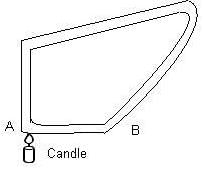
Ans:
False, water moves in a clockwise direction because on heating, water rushes from higher pressure area near B to lower pressure area near A.
Q.9: The acceleration- time graph for a body is shown in the given figure. Plot the corresponding velocity-time graph. (2)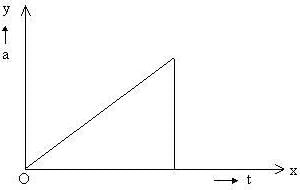
Ans:
The corresponding velocity- time graph is
Q.10: A body of mass 5 kg is acted upon by two perpendicular forces of magnitude 8 N and 6 N. Find the magnitude and direction of the acceleration. (2)
Ans:
The two perpendicular forces acting on the body are shown below in the figure.
Let =
∴
Acceleration
Direction of acceleration ( a ) will be the direction of force F , i.e.,
Q.11: A ball is dropped vertically from rest at a height of 12 m. After striking the ground, it bounces to a height of 9 m. What fraction of kinetic energy does it loose on striking the ground? (2)
Ans:
Let m be the mass of the body.
When the body falls from some height, potential energy at the top equals the gain in kinetic energy. The body loses some kinetic energy and again rises to some different height.
∴ Percentage loss in K.E.
Q.12: If the angular momentum is conserved in a system whose moment of inertia is decreased. Will its rotational kinetic energy be also conserved? (2)
Ans:
According to the law of conservation of angular momentum
As
Or
Thus, the rotational kinetic energy of the system increases on decreasing its moment of inertia.
Q.13: Assuming that the Earth’s orbit is a circle of radius1.5 ´108 km . Calculate the mass of the sun. (2)
OR
The change in the value of g at a height h above the Earth is same as at a depth d below it. If h and d are compared to the radius of the earth. What is the ratio (hd)? (2)
Ans:
The gravitational force of attraction between the Earth and the Sun provides the necessary centripetal force.
∴
or
Substituting the values and simplifying, we get
OR
We know that, g at height h is given by
And similarly, we have g at depth d is given by
But gh =gd
∴
Q.14: (i) Distinguish between an isothermal and an adiabatic process.
(ii) Distinguish between an isochoric and isobaric processes. (2)
Ans:
(i) An isothermal process is that process in which the temperature ( T ) of the system remains constant though other variables ( P and V ) may change.
Here, ΔT= 0
In an adiabatic process, the total heat content ( Q ) of the system remains constant though other variables ( P and T ) may change.
In this process, ΔQ= 0
(ii) A process in which volume ( V ) remains constant though other variables ( P and T ) may change, is called an isochoric process.
In this process, ΔV= 0
An isobaric process is that for which pressure (P) of the system remains constant though other variables (V and T) may change.
In this process, ΔP= 0
Q.15: A person is measuring the velocity of sound in an experiment. He found that velocity of sound increases by 61 cm/s for every 1o C. Show this mathematically. (2)
Ans:
We know that,
Where , V0 ,Vt are the velocities of sound at T and T0 respectively.
∴
Neglecting the higher power
∴
Thus, the velocity of sound increases by 61 cm/s for every 1o C ( or 1 K ) rise in the temperature.
Q.16: A waterfall is 100 m high. How much warmer will the water be after the fall? Assume that all the work gets converted into the heat energy. Take the average value of g to be 980 cm/s2 .(2)
Ans:
Since work done W = mgh
W =m * 980 * 100 * 100 ergs
∴ J = 4.2 * 107 ergs/cal
We know, heat energy
Q.17: It has been suggested that for liquids  is a constant, with s being the surface tension and β the compressibility, show that K is not a dimensionless constant. (3)
is a constant, with s being the surface tension and β the compressibility, show that K is not a dimensionless constant. (3)
Ans:
We know that,
Now,
Thus, k is not a dimensionless constant, but is a constant with dimensions.
Q.18: It is easier to pull a lawn roller than to push it. Explain using the resolution of forces. (3)
Ans:
W is weight of the lawn roller. When pushed by applying a forceat an angleθ . F cosθ moves it forward while the apparent weight becomes W +F sinθ.
However when pulled, the apparent weight becomes W -F sinθ .
Since the force of friction is directly proportional to normal reaction (equal to apparent weight of the roller), it is more when it is pushed than when is pulled.
Q.19: A long playing record revolves with a speed of  and has a radius of 15 cm.
and has a radius of 15 cm.
Two coins are placed at 4 cm and 14 cm away from the centre of the record. If the coefficient of friction between the coins and the record is 0.15. Which of the two coins will revolve with the record? (3)
Ans:
The coin will only revolve with the record if the maximum force due to friction is sufficient enough to balance the centripetal force.
Maximum force due to static force
or
∴
Solving we get,
Thus, the coin placed at 4 cm will revolve with the record.
Q.20: A car drives along the straight level frictionless road by an engine delivering constant power. How is velocity of the car related to time elapsed? (3)
Ans:
Power P = Fv
Integrating both sides, we get
or v2αt
i.e.
Q.21: Prove that the impulse received during an impact is equal to the total change in momentum produced during the impact. (3)
Ans:
We know that,
If the impact lasts for a small time dt and the momentum of the body changes fromthen,
varies with time and does not remain constant.
is a measure of the impulse of the force.
Letbe the constant force during the impact, then
∴
Thus, the impulse received during an impact is equal to the total change in momentum produced during the impact.
Q.22: While approaching a planet circling a distant star, a space traveller determines the planet’s radius to be half that of the Earth. After landing on the surface he finds the acceleration due to gravity to be twice that on the surface of the Earth. Find the ratio of the mass of the planet to that of the Earth. (3)
Ans:
In case of the Earth,
In case of the planet,
Dividing these two equations, we get
But gp = 2ge
and
∴
Thus the ratio of the mass of the planet to the mass of the Earth is 1/2 .
Q.23: Oil spreads over the surface of water, whereas water does not spread over the surface of oil. Why? (3)
Ans:
The surface tension of water is more than that of oil. Therefore, when oil is poured over water, greater value of surface tension of water pulls the oil in all directions and as such it spreads on the water. On the other hand, when water is poured over oil, it does not spread over it because the surface tension of oil being less than that of water, it is not able to pull water over it.
Q.24: Two vessels of the same size are at the same temperature. One of them holds 1 kg of N2 gas and the other contains 1 kg of H2 gas.
(i) Which of the vessels contains more molecules?
(ii) Which of the vessels is under greater pressure and why?
(iii) In which vessel is the average molecular speed greater? How many times is it greater?(3)
Ans:
(i) Hydrogen will have more. As 2 g of hydrogen contains N molecules, I kg of hydrogen contains
molecules, where N = 6.023*1023 , In case of N2 , 28 g of nitrogen contains N molecules. Therefore, 1 kg of nitrogen contains
(ii) Vessel containing hydrogen will have more pressure.
Since M and V are the same in both the cases,therefore the pressure exerted by hydrogen is more than that by nitrogen.
Q.25: State the law of equipartition of energy. Show that the ratio of specific heat at constant pressure to specific heat at constant volume is 7/5 for a rigid diatomic molecule. (3)
Ans:
In equilibrium, the total energy is equally distributed in all possible energy modes, with each mode having an average energy equal to 1/2kT. This is the law of equipartition of energy.
A diatomic molecule that can be taken as a rigid rotator with 5 degrees of freedom: 3 translational and 2 rotational. Using the law of equipartition of energy the total internal energy of a mole of such a gas is given by
Then molar specific heat at constant volume
and molar specific heat at constant pressure
Q.26: An old woman crossing the road was holding a purse. She was not able to walk. A pick pocket snatched away her purse. A school student of class XI saw this and tried to help the old lady. He informed the police inspector who stood nearby. The inspector chased the pick pocket, collected the purse from him and handed it over to the old lady.
(a) What values do you find in the school student?
(b) The police inspector is chasing the pickpocket on a straight road. The jeep is going at its maximum speed v. The pickpocket rides on a motorcycle when the jeep is at a distance d away and the motorcycle moves with a constant acceleration a. Show that the pickpocket will be caught if  (4)
(4)
Ans:
(a) The student is sympathetic towards others and is helping in nature, applied his presence of mind in solving the problems and knows how to use public services.
Pickpocket will be caught if s+d = vt
t should be real.
This is possible if
Q.27: A particle is thrown over a triangle from one end of a horizontal base that grazing the vertex falls on the other end of the base. If α and β be the base angles and θ the angle of projection, prove that tanθ = tanα+ tanβ (5)
OR
(a) A balloon is ascending at the rate of 14 ms-1 at a height of 98 m above the ground, when a packet is dropped from it. After how much time and with what velocity does it reach the ground?
(b) Do the following two graphs represent same types of motion? Name the motion.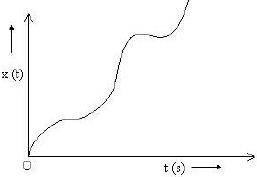
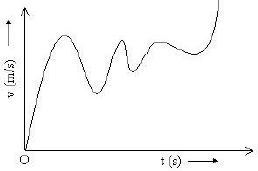
Ans:
The statement in the question is shown in the diagram.
Where R is horizontal range.(i)
(ii)
(iii)
From eq. (ii) and (iii)
or
Put (iv) in (i) , we get
Or
(a) When the packet is dropped, it has a velocity of 14ms -1 in the upward direction. Taking the upward direction as +ve and down ward direction as -ve.
We have
∴
Considering only the +ve sign
v(t) = v(0) + at
Thus, the final velocity of the body is along the downward direction.
(b) Both the graphs represent non-uniform motion.
Ques 28: (i) Prove that the isothermal elasticity of a gas is equal to its pressure.
(ii) Prove that the adiabatic elasticity of the gas = γ * P , where P is pressure of the gas and  being the specific heats of the gas at constant pressure and constant volume respectively. (5)
being the specific heats of the gas at constant pressure and constant volume respectively. (5)
OR
The difference between the length of a certain brass rod and that of steel rod is claimed to be constant at all temperatures. Is it possible? (5)
Ans:
(i) Let there be a gas at constant pressure P and volume V . When the pressure increases from P to P + Δp , the volume decreases from V to V - ΔV.
Bulk modulus,
When the gas is impressed isothermally, Boyle’s law holds good, i.e.
PV = constant,
Differentiating w. r. t. V , we get
or
Thus, the isothermal elasticity of a gas is equal to its pressure. When the gas is compressed adiabatically, we get
Differentiating w. r. t. V , we get
Thus, the adiabatic elasticity of a gas is γ times the pressure of the gas.
Or
At a given temperature, let the length of the brass rod be L1 , and that of the steel rod be L2 . If L2 >L1 , the difference between the lengths = L2 - L1 = ΔL.
Let the temperature be raised to toC .
∴ Length of the brass rod at toC = L1+ L1α1t
Length of the steel rod at toC = L2+ L2α 2t
∴ Here α1 and α2 are the coefficients of brass and steel respectively.
Difference between the lengths of the rods at toC , say
The difference remains that same at all temperatures
Thus, the length of the rods must be inversely proportional to the linear coefficient of their materials.
Ques 29: If the earth were a homogeneous sphere and a straight hole bored in it through its center. Show that if a body were dropped into the hole, it would execute a simple harmonic motion. Also find its time period. (5)
OR
(i) Derive an expression for finding the velocity of an approaching aeroplane using radar waves.
(ii) An ultrasonic wave of frequency 45, 000 Hz sent out by sonar shows a frequency rise of 600 Hz on reflection from an approaching submarine. If the velocity of sound in water is 1500 ms-1. Calculate the speed of the submarine. (5)
Ans:
Let a body of man m be dropped in a straight hole in the Earth of them M and radius R . The body will be attracted towards the centre of the Earth with a force given by,
But F = mg
∴
Or
Where ρ is mean density of the Earth.
When the body is dropped into the straight hole and it falls through the depth d , the value of acceleration due to gravity at the point P is given by,
Where M ' is the mass of the sphere of radius ( R -d)
Thus,
or
i.e., acceleration (in magnitude) of the body is proportional to the displacement from the centre of the earth O. Thus, the motion is SHM.
Time period,
Or
(i) The radar waves sent form the Earth strike the approaching aeroplane. Here the radar is a source which is stationary and the aeroplane is an observer which is moving towards the stationary source. We have to determine the velocity to the approaching plane.
∴ Apparent frequency, =
Where n is the velocity of the radar waves and vs is the velocity of the aeroplane.
Now the aero plane receives waves of frequency n ' and acts as a source moving towards stationary observer, i.e. radar on the Earth. Since on reflection, the frequency does not change, the aero plane will reflect waves of frequency n'.
∴ Apparent frequency received by the radar is given by,
Using the binomial theorem as
or
Thus, velocity of an approaching aero plane is
(ii) Substituting the values given in the above expression, we have
Thus, the speed of the submarine is 10 m/s .
|
83 videos|253 docs|174 tests
|
FAQs on Sample Paper 1 with Solution: Physics, Class 11 - Physics for Grade 11
| 1. What are the fundamental laws of motion? |  |
| 2. What is the difference between mass and weight? |  |
| 3. How does the motion of an object change when different forces act on it? |  |
| 4. What is the relationship between force and motion? |  |
| 5. How does Newton's Third Law of Motion explain the motion of rockets? |  |





